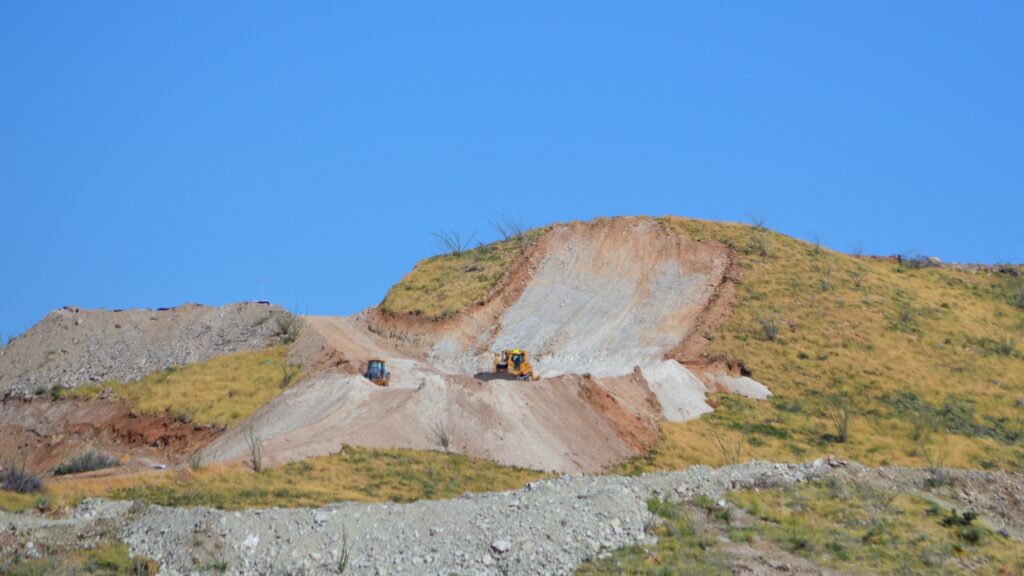
Bulldozers prepare the site for Hudbay Minerals mining operations in the Santa Rita Mountains south of Tucson. Photo by David Abbott | Arizona Mirror
An environmental advocacy group and the state’s largest pecan farming company filed an appeal Tuesday challenging a state land board’s approval of a controversial right-of-way needed for a proposed $1.3 billion copper mining project southeast of Tucson.
Save the Scenic Santa Ritas and Farmers Investment Co. argue the Arizona State Land Department violated state law and the Arizona Constitution by granting Copper World Inc. permission to build infrastructure across protected research land.
The appeal follows a September court victory in which Maricopa County Superior Court Judge Scott Blaney ruled the state land board violated Arizona’s Open Meetings Law by failing to disclose the right-of-way would be used for pipelines to transport millions of tons of mine waste, known as tailings.
“The Santa Rita Experimental Range is required by state law to be operated for ecological and rangeland research,” Rob Peters, executive director of Save the Scenic Santa Ritas, said in a written statement announcing the new litigation. “The Arizona State Land Department violated state law, the state Constitution, and department regulations when it granted the right-of-way to Copper World for industrial uses.”
The right-of-way would allow Copper World, a subsidiary of Canadian mining company Hudbay Minerals Inc., to construct power lines, communications lines, and pipelines for water and mine waste across the Santa Rita Experimental Range, a 52,000-acre research facility established in 1902.
GET THE MORNING HEADLINES.
The most recent Copper World proposal would span 44 years in two phases, beginning on the west side of the mountain range near the town of Green Valley. The first phase would include a 17-year mine life on property that Hudbay already owns.
That initial phase would allow the multinational corporation ample time to obtain permits required to mine on the public lands to the east of the initial site. Once fully completed, operations would obliterate a 1.5-mile stretch of ridgeline and leave millions of tons of mine waste behind.
Pima County has publicly opposed the project since at least 2011.
At issue is whether the land department circumvented legal protections for the range. In 1988, the Arizona Legislature mandated it be used only for research and a 1991 Land Department order closed it to development, including rights-of-way.
“The Legislature did not authorize the land department to create a bureaucratic scheme to grant a foreign mining company industrial rights-of-way across the ecologically sensitive range,” Nan Walden, chief counsel for Farmers Investment Co., which operates pecan farms near the proposed mine site, said in a statement.
The appeal challenges an Oct. 8 land board decision that attempted to rectify open meetings violations from December 2022. The earlier approval was invalidated after Blaney found the board failed to inform the public that the right-of-way would include six pipelines for mine tailings rather than the two water pipelines originally disclosed.
According to Save the Scenic Santa Ritas and Farmers Investment Co., the re-approval of the right-of-way for the project once again failed to provide a detailed description of the project and the mine tailings pipelines.
Copper World plans multiple open pit mines on both sides of the Santa Rita Mountains, about 35 miles southeast of Tucson. The project includes the controversial Rosemont pit and would place “hundreds of millions of tons of mine waste” on private land next to the research range, according to court documents.
“We will continue to pursue all legal options to stop this horrific mining project that will destroy the northern half of the Santa Rita Mountains, deplete billions of gallons of groundwater from the Santa Cruz River valley, pollute the air, dump hundreds of millions of tons of toxic mine tailings near existing neighborhoods and schools all to mine copper that will be exported overseas,” Peters said.
The Santa Rita Experimental Range, originally operated by the U.S. Forest Service until its transfer to Arizona in 1988, is “the longest continuously active rangeland research facility and among the five oldest biological field stations in the United States,” according to range officials.
The Arizona State Land Department said it would not comment on pending litigation, and a spokesperson for Hudbay said the mining company was reviewing the filing.
YOU MAKE OUR WORK POSSIBLE.

